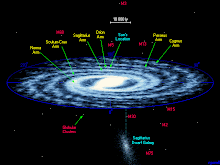
GALAXIES:
A galaxy is a huge mass of stars, nebulae, and interstellar material. The smallest galaxies contain about 100,000 stars, while the largest galxies contain up to 3,000 billion stars. there are three main types of galaxy, classified according to their shape: elliptical, which are oval shaped; spiral, which have arms spiralling outwards from a central bulge; and irregular, which have no obvious shape. sometimes, the shape of galaxy is distorted by a collision with another galaxy. Quasar (quasi-stellar objects) are thoght to be galactic nuclei but are so far away that that thier exact nature is still uncertain. They are conpact, highly luminous objects in the outer reaches of the known Universe: while the furthest known "ordinary" galaxies are about 10 billion light years aways, the futhest known quasar is about 15 billion light years away. Active galaxies, such as Seyfert galaxies and radio galaxies, emit intense radiation. In a Seyfert galaxy, this radiation comes from the galactic nucleus; in a radio galaxy, it also comes from huge lobes on either side of the galaxy. The radiation from active galaxies and quasars is thought to be caused by black holes.
THE MILKY WAY:
The Milky Way is the name given to the faint band of light visible at night that stretches across the night sky. The name Milky Way is derived from Greek mythology, in which the band of light was said to be milk from the breast of the goddess Hera. Its hazy appearance results from the combined light of stars too far away to be distinguished individually by the unaided eye. All of the individual stars that are distinct in the sky lie within the Milky Way Galaxy or simply "the Galaxy".
The Galaxy is shaped like a spiral, with a dense central bulge that is encircled by four arms spiralling outwards and surrounded by a less dense halo. Our own solar system exists within one of the spiral arms, the Orion Arm (also called the Local Arm). From our position, the centre of the galaxy is completed obscured by dust clouds; as a result, optical maps give only a limited view of the Galaxy. However, a more complex picture can be obtained by studying, radio, infra-red, and other radiations. The central bulge of the Galaxy is a relatively small, dense sphere that contains mainly older red and yellow stars. The halo is a less dense region in which the oldest starts are situated; some of these stars may be as old as the Ga;axy itself (possibly 15 billion years). the spiral arms contain mainly hot, young, blue stars, as well as nebulae (clouds of dust and gas inside which stars are born). The Galaxy is vast, about 100,000 light years across (a light year is about 9,460 billion kilometres); in comparision, the Solar System seems small, at about 12 light hours across (about 13 billion kilometres). The entire Galaxy is rotating in space, although the inner stars travel faster than those further out. The Sun, which is about two-thirds out from the centre, completes one lap of the galaxy about every 220 million years.
This false-color image looks toward the center of the Milky Way, located 30,000 light-years away. Bright star clusters are visible along with darker areas of dust and gas.
References:
http://struckbyenlightning.files.wordpress.com/2009/10/milky-way-galaxy-sun.jpg
Book: DK Ultimate Visual dictionary

